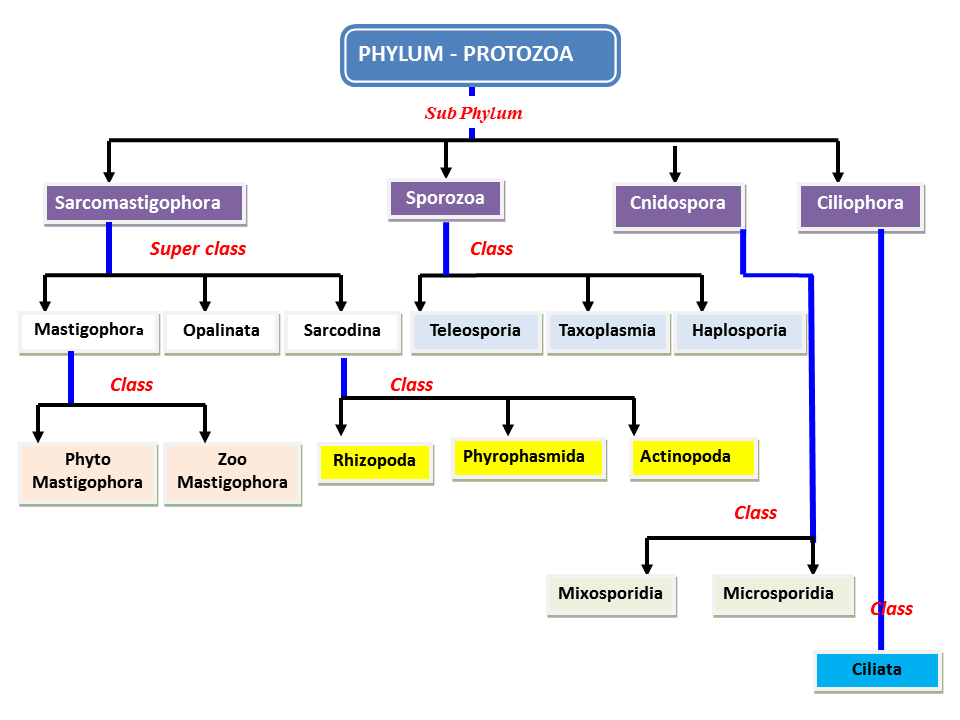
Myonemes are the fine contractile structures in the pellicle and best developed in class___
A) Sarcodina
B) Ciliata
C) Sporozoa
D) All of the above
Answer
576k+ views
Hint: Pellicle provides protection to the cell membrane in many types of protozoa. It is like a blanket of protein for extra security to the unicellular organisms of the kingdom Protista under the class Protozoa.
Complete Answer:
What exactly is the pellicle? A pellicle is a very thin layer of protein that protects cell membranes in many types of protozoa, which are free-living or parasitic single-celled eukaryotes that feed on organic matter such as other microorganisms or organic tissues and debris.
The members of protozoa like Plasmodium, Paramecium, Leishmania, are heterotrophic. They either depend on the decomposing of the organic matter to obtain the nutrients or depend on the host cells, in which they cause the disease. The pellicle serves as an additional advantage to these single-celled organisms to thrive and function.
The pellicle, which is directly below the cell membrane and surrounds the cytoplasm, allows organisms like paramecia and ciliates to hold their shapes. The fine layers of translucent membranes also facilitate movement because it is flexible owing to its proteinaceous makeup. The contractile myonemes help in movement by contracting and relaxing.
Myonemes, as evident by their function that we have just discussed, as such protein filaments that can contract when exposed to the calcium ions.
The options provided to us are the classes of Protozoa (as shown below), therefore, all of these will have the myonemes present in the pellicle.

Therefore, the correct answer is option D.
Note: Most of the protozoans are either parasitic or saprophytic, therefore, the pellicle also plays an important role in protection.
Complete Answer:
What exactly is the pellicle? A pellicle is a very thin layer of protein that protects cell membranes in many types of protozoa, which are free-living or parasitic single-celled eukaryotes that feed on organic matter such as other microorganisms or organic tissues and debris.
The members of protozoa like Plasmodium, Paramecium, Leishmania, are heterotrophic. They either depend on the decomposing of the organic matter to obtain the nutrients or depend on the host cells, in which they cause the disease. The pellicle serves as an additional advantage to these single-celled organisms to thrive and function.
The pellicle, which is directly below the cell membrane and surrounds the cytoplasm, allows organisms like paramecia and ciliates to hold their shapes. The fine layers of translucent membranes also facilitate movement because it is flexible owing to its proteinaceous makeup. The contractile myonemes help in movement by contracting and relaxing.
Myonemes, as evident by their function that we have just discussed, as such protein filaments that can contract when exposed to the calcium ions.
The options provided to us are the classes of Protozoa (as shown below), therefore, all of these will have the myonemes present in the pellicle.

Therefore, the correct answer is option D.
Note: Most of the protozoans are either parasitic or saprophytic, therefore, the pellicle also plays an important role in protection.
Recently Updated Pages
Master Class 8 Social Science: Engaging Questions & Answers for Success

Master Class 8 Science: Engaging Questions & Answers for Success

Master Class 8 Maths: Engaging Questions & Answers for Success

Class 8 Question and Answer - Your Ultimate Solutions Guide

Full form of MODEM?

What is a numerical label assigned to each device in a network?

Trending doubts
What is BLO What is the full form of BLO class 8 social science CBSE

What is 1 divided by 0 class 8 maths CBSE

In Indian rupees 1 trillion is equal to how many c class 8 maths CBSE

Citizens of India can vote at the age of A 18 years class 8 social science CBSE

Today is Monday After 61 days it will be aWednesda-class-8-maths-CBSE

Write a letter to your class teacher asking for 2 days class 8 english CBSE




